Information System Analysis: Project Cost, Schedule, and Stakeholders
VerifiedAdded on 2021/02/20
|11
|2332
|32
Report
AI Summary
This report provides a comprehensive analysis of information systems, focusing on system development approaches such as the Waterfall, V-shaped, Prototype, and Spiral models, with the Waterfall model being recommended for the 'Repair Made Easy' system. It details system requirements, in...
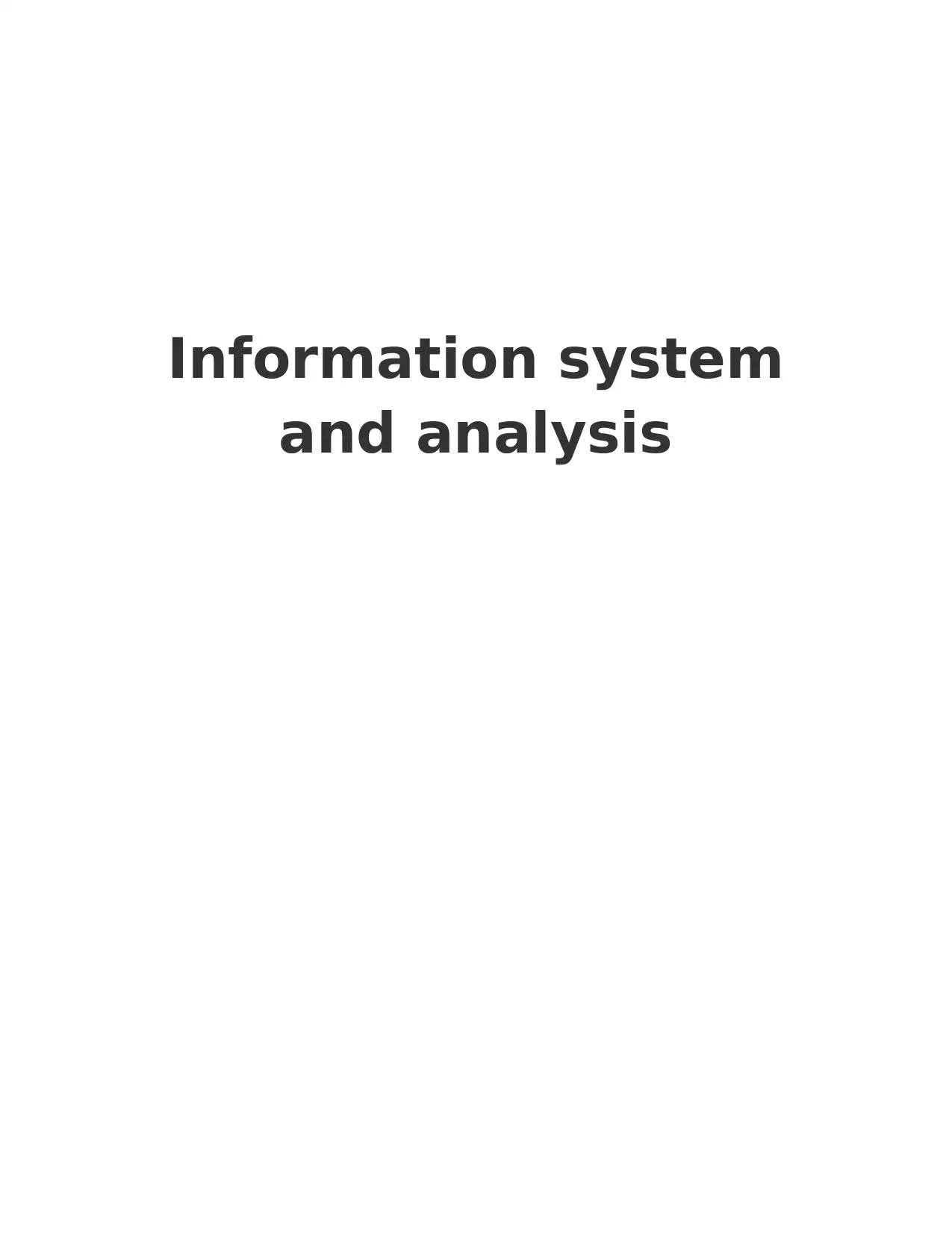
Information system
and analysis
and analysis
Paraphrase This Document
Need a fresh take? Get an instant paraphrase of this document with our AI Paraphraser

Table of Contents
INTRODUCTION...........................................................................................................................1
Approaches to Systems Development.............................................................................................1
Systems Requirements.....................................................................................................................2
Project Cost/Benefit Analysis..........................................................................................................3
Project Management and Scheduling..............................................................................................5
System Information Requirement Investigation Techniques..........................................................7
Reflections and Conclusions............................................................................................................8
REFERENCES................................................................................................................................9
INTRODUCTION...........................................................................................................................1
Approaches to Systems Development.............................................................................................1
Systems Requirements.....................................................................................................................2
Project Cost/Benefit Analysis..........................................................................................................3
Project Management and Scheduling..............................................................................................5
System Information Requirement Investigation Techniques..........................................................7
Reflections and Conclusions............................................................................................................8
REFERENCES................................................................................................................................9
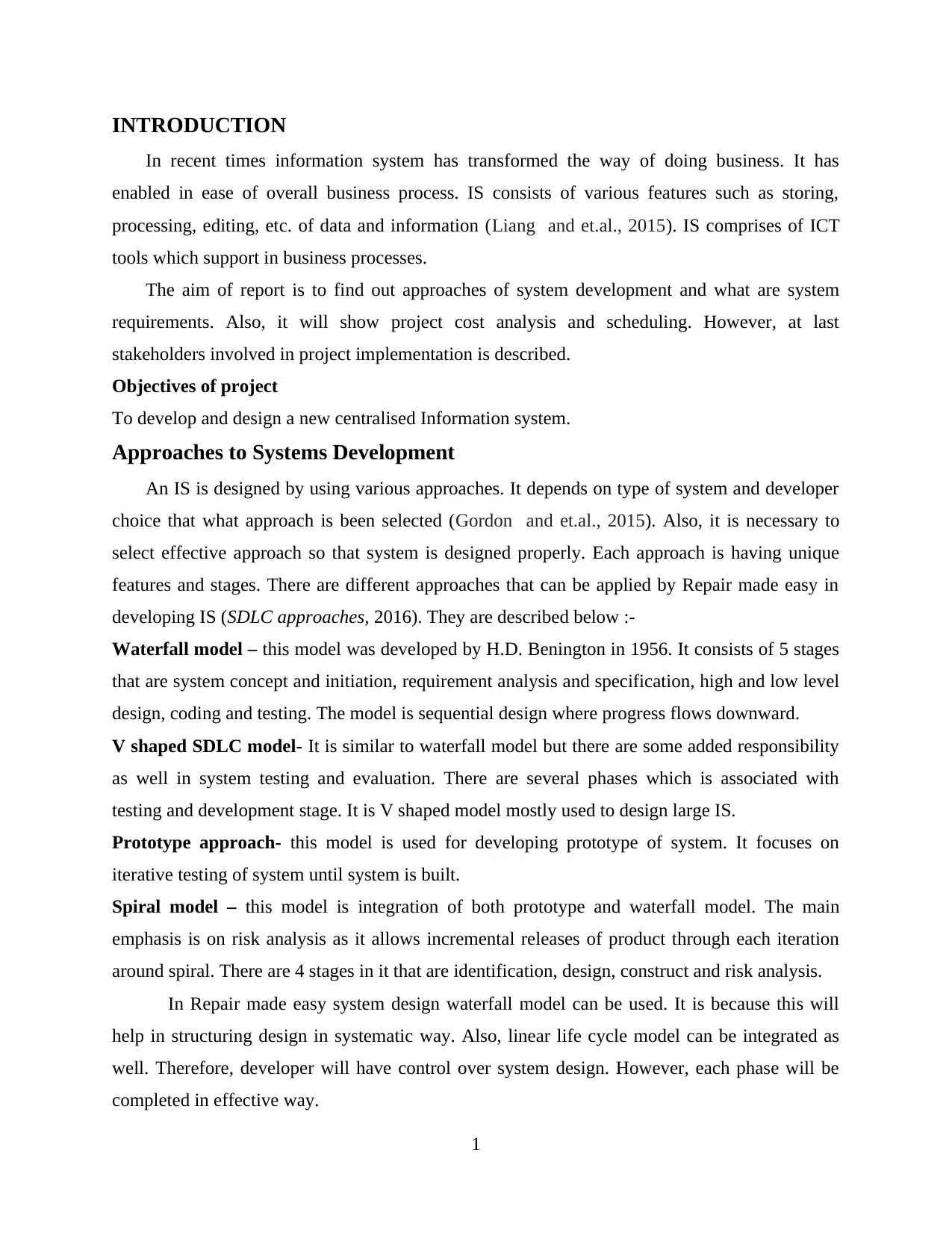
INTRODUCTION
In recent times information system has transformed the way of doing business. It has
enabled in ease of overall business process. IS consists of various features such as storing,
processing, editing, etc. of data and information (Liang and et.al., 2015). IS comprises of ICT
tools which support in business processes.
The aim of report is to find out approaches of system development and what are system
requirements. Also, it will show project cost analysis and scheduling. However, at last
stakeholders involved in project implementation is described.
Objectives of project
To develop and design a new centralised Information system.
Approaches to Systems Development
An IS is designed by using various approaches. It depends on type of system and developer
choice that what approach is been selected (Gordon and et.al., 2015). Also, it is necessary to
select effective approach so that system is designed properly. Each approach is having unique
features and stages. There are different approaches that can be applied by Repair made easy in
developing IS (SDLC approaches, 2016). They are described below :-
Waterfall model – this model was developed by H.D. Benington in 1956. It consists of 5 stages
that are system concept and initiation, requirement analysis and specification, high and low level
design, coding and testing. The model is sequential design where progress flows downward.
V shaped SDLC model- It is similar to waterfall model but there are some added responsibility
as well in system testing and evaluation. There are several phases which is associated with
testing and development stage. It is V shaped model mostly used to design large IS.
Prototype approach- this model is used for developing prototype of system. It focuses on
iterative testing of system until system is built.
Spiral model – this model is integration of both prototype and waterfall model. The main
emphasis is on risk analysis as it allows incremental releases of product through each iteration
around spiral. There are 4 stages in it that are identification, design, construct and risk analysis.
In Repair made easy system design waterfall model can be used. It is because this will
help in structuring design in systematic way. Also, linear life cycle model can be integrated as
well. Therefore, developer will have control over system design. However, each phase will be
completed in effective way.
1
In recent times information system has transformed the way of doing business. It has
enabled in ease of overall business process. IS consists of various features such as storing,
processing, editing, etc. of data and information (Liang and et.al., 2015). IS comprises of ICT
tools which support in business processes.
The aim of report is to find out approaches of system development and what are system
requirements. Also, it will show project cost analysis and scheduling. However, at last
stakeholders involved in project implementation is described.
Objectives of project
To develop and design a new centralised Information system.
Approaches to Systems Development
An IS is designed by using various approaches. It depends on type of system and developer
choice that what approach is been selected (Gordon and et.al., 2015). Also, it is necessary to
select effective approach so that system is designed properly. Each approach is having unique
features and stages. There are different approaches that can be applied by Repair made easy in
developing IS (SDLC approaches, 2016). They are described below :-
Waterfall model – this model was developed by H.D. Benington in 1956. It consists of 5 stages
that are system concept and initiation, requirement analysis and specification, high and low level
design, coding and testing. The model is sequential design where progress flows downward.
V shaped SDLC model- It is similar to waterfall model but there are some added responsibility
as well in system testing and evaluation. There are several phases which is associated with
testing and development stage. It is V shaped model mostly used to design large IS.
Prototype approach- this model is used for developing prototype of system. It focuses on
iterative testing of system until system is built.
Spiral model – this model is integration of both prototype and waterfall model. The main
emphasis is on risk analysis as it allows incremental releases of product through each iteration
around spiral. There are 4 stages in it that are identification, design, construct and risk analysis.
In Repair made easy system design waterfall model can be used. It is because this will
help in structuring design in systematic way. Also, linear life cycle model can be integrated as
well. Therefore, developer will have control over system design. However, each phase will be
completed in effective way.
1
⊘ This is a preview!⊘
Do you want full access?
Subscribe today to unlock all pages.

Trusted by 1+ million students worldwide

Systems Requirements
In order to design a system it is necessary to determine system requirements. It provides
brief overview about resources required and its cost (Gourlis and Kovacic, 2017). Moreover,
with help of this it is easy to design system and execute it. Basically, there are two common
requirement explained below :-
Functional requirements – these are basic requirements to design a new system. They are
product components which allow user to complete their tasks and specify behaviour between
output and input. The functional requirements are as follows :-
SRS- This is the most important requirement in system. It is a document in which hardware and
software requirements are described. In addition it contains functions, constraints, etc. required
in system. Also, database, system and functional requirements are mentioned in this.
Use cases- It describe interaction between user and system.
User stories- A document which shows what user want software within system to perform
operations.
Software prototypes- Here, it is mentioned about that how system requirements must be
implemented. The prototypes enable in providing solution and showing example that how user
will interact with system (Hughes and et.al., 2016).
Design documents – in this design requirement of system is described. It includes wireframe,
mock-ups, etc. of interface of system.
Non functional requirements- they specify criteria that how system behave and includes
different attributes such as security, performance, reliability, scalability, etc.
Usability – It defines to what extent it is difficult for user to operate system. In this there are
many elements included such as efficiency of use, workload, etc. (de Gusmão and et.al., 2016)
Security – It ensures that system is been protected from unauthorised access. This shows that
how data will be protected, who will have access to it, etc. Moreover, it includes authority and
authenticity of system and data.
Reliability- It gives an insight about how well system will perform in case of failure in particular
time.
2
In order to design a system it is necessary to determine system requirements. It provides
brief overview about resources required and its cost (Gourlis and Kovacic, 2017). Moreover,
with help of this it is easy to design system and execute it. Basically, there are two common
requirement explained below :-
Functional requirements – these are basic requirements to design a new system. They are
product components which allow user to complete their tasks and specify behaviour between
output and input. The functional requirements are as follows :-
SRS- This is the most important requirement in system. It is a document in which hardware and
software requirements are described. In addition it contains functions, constraints, etc. required
in system. Also, database, system and functional requirements are mentioned in this.
Use cases- It describe interaction between user and system.
User stories- A document which shows what user want software within system to perform
operations.
Software prototypes- Here, it is mentioned about that how system requirements must be
implemented. The prototypes enable in providing solution and showing example that how user
will interact with system (Hughes and et.al., 2016).
Design documents – in this design requirement of system is described. It includes wireframe,
mock-ups, etc. of interface of system.
Non functional requirements- they specify criteria that how system behave and includes
different attributes such as security, performance, reliability, scalability, etc.
Usability – It defines to what extent it is difficult for user to operate system. In this there are
many elements included such as efficiency of use, workload, etc. (de Gusmão and et.al., 2016)
Security – It ensures that system is been protected from unauthorised access. This shows that
how data will be protected, who will have access to it, etc. Moreover, it includes authority and
authenticity of system and data.
Reliability- It gives an insight about how well system will perform in case of failure in particular
time.
2
Paraphrase This Document
Need a fresh take? Get an instant paraphrase of this document with our AI Paraphraser
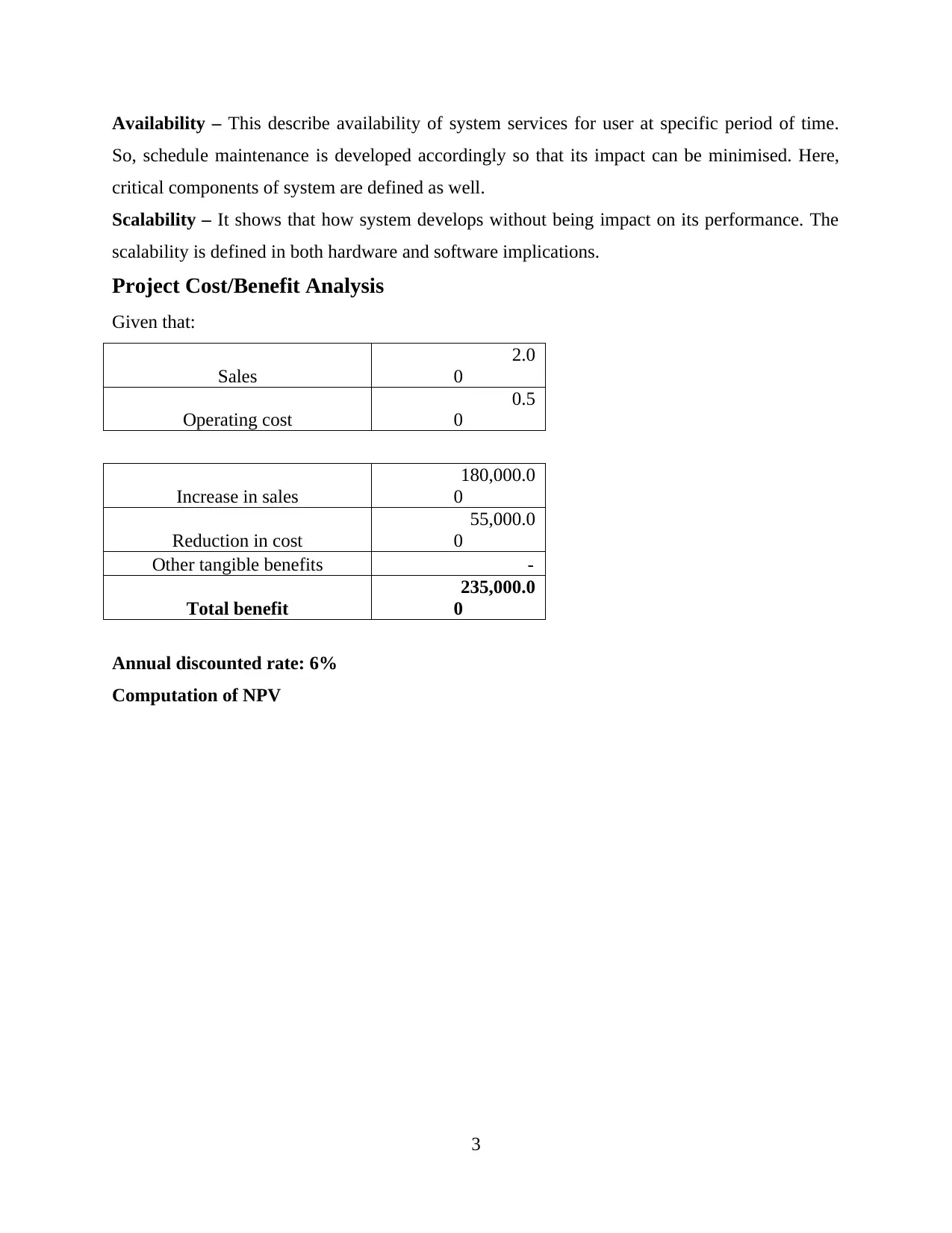
Availability – This describe availability of system services for user at specific period of time.
So, schedule maintenance is developed accordingly so that its impact can be minimised. Here,
critical components of system are defined as well.
Scalability – It shows that how system develops without being impact on its performance. The
scalability is defined in both hardware and software implications.
Project Cost/Benefit Analysis
Given that:
Sales
2.0
0
Operating cost
0.5
0
Increase in sales
180,000.0
0
Reduction in cost
55,000.0
0
Other tangible benefits -
Total benefit
235,000.0
0
Annual discounted rate: 6%
Computation of NPV
3
So, schedule maintenance is developed accordingly so that its impact can be minimised. Here,
critical components of system are defined as well.
Scalability – It shows that how system develops without being impact on its performance. The
scalability is defined in both hardware and software implications.
Project Cost/Benefit Analysis
Given that:
Sales
2.0
0
Operating cost
0.5
0
Increase in sales
180,000.0
0
Reduction in cost
55,000.0
0
Other tangible benefits -
Total benefit
235,000.0
0
Annual discounted rate: 6%
Computation of NPV
3
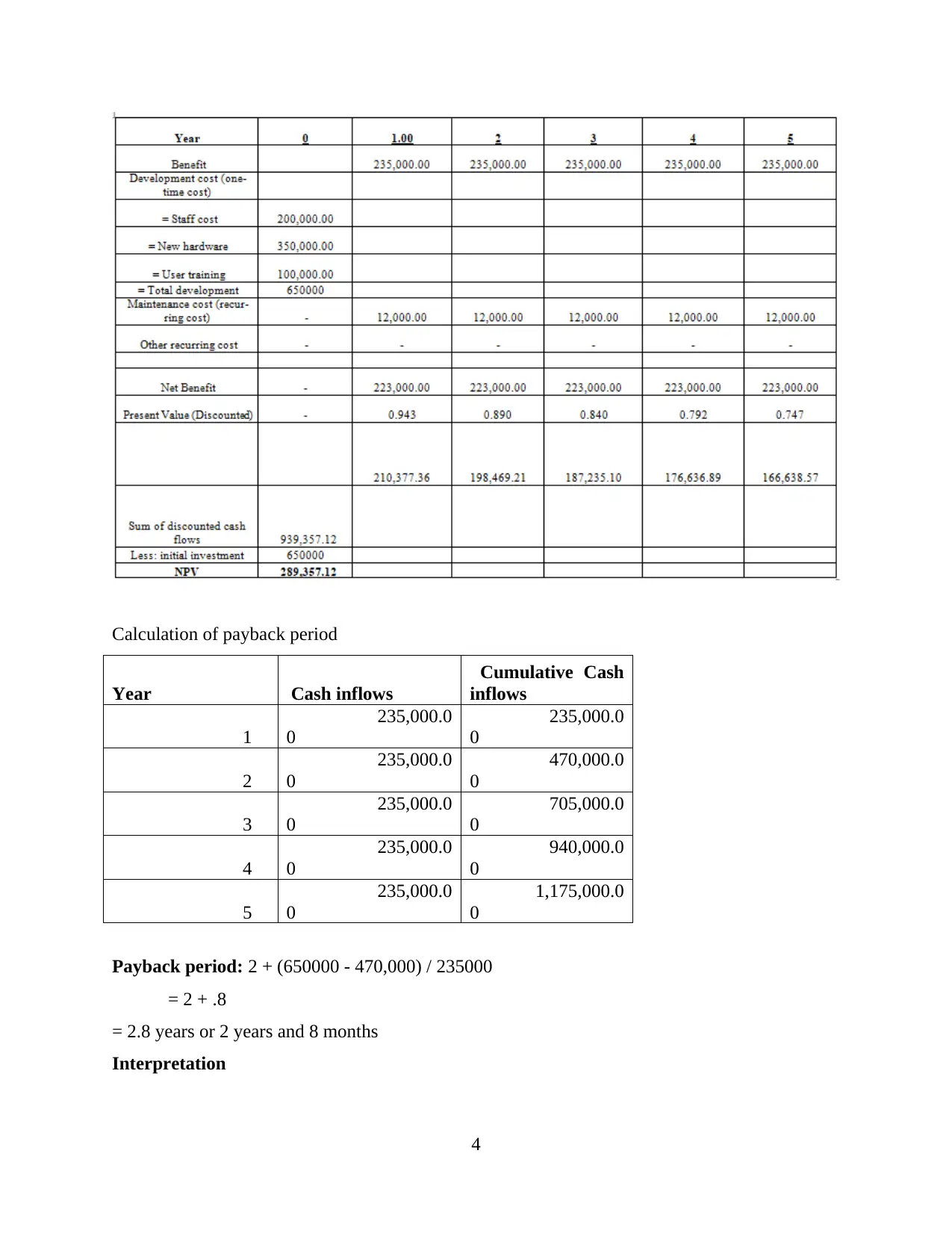
Calculation of payback period
Year Cash inflows
Cumulative Cash
inflows
1
235,000.0
0
235,000.0
0
2
235,000.0
0
470,000.0
0
3
235,000.0
0
705,000.0
0
4
235,000.0
0
940,000.0
0
5
235,000.0
0
1,175,000.0
0
Payback period: 2 + (650000 - 470,000) / 235000
= 2 + .8
= 2.8 years or 2 years and 8 months
Interpretation
4
Year Cash inflows
Cumulative Cash
inflows
1
235,000.0
0
235,000.0
0
2
235,000.0
0
470,000.0
0
3
235,000.0
0
705,000.0
0
4
235,000.0
0
940,000.0
0
5
235,000.0
0
1,175,000.0
0
Payback period: 2 + (650000 - 470,000) / 235000
= 2 + .8
= 2.8 years or 2 years and 8 months
Interpretation
4
⊘ This is a preview!⊘
Do you want full access?
Subscribe today to unlock all pages.

Trusted by 1+ million students worldwide
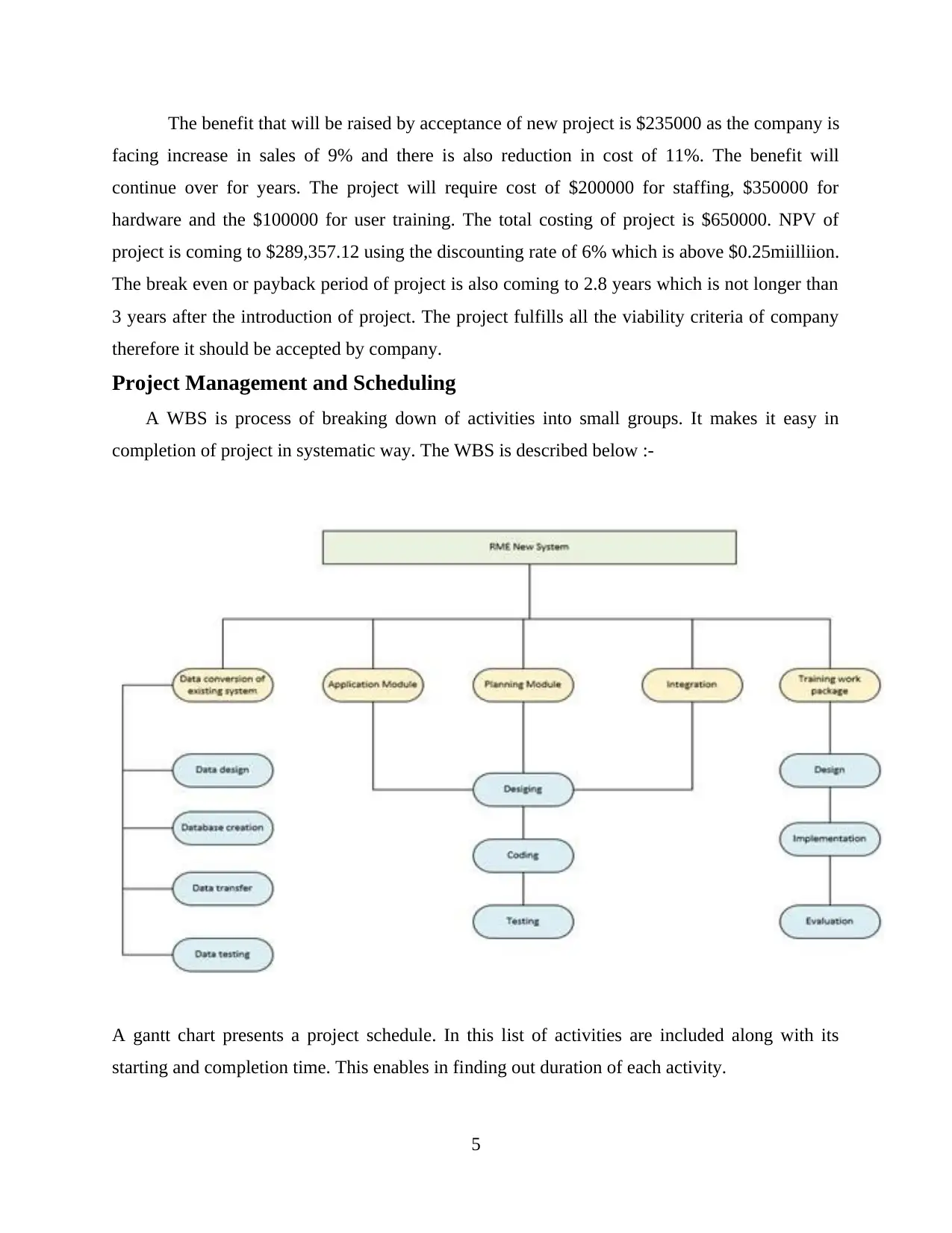
The benefit that will be raised by acceptance of new project is $235000 as the company is
facing increase in sales of 9% and there is also reduction in cost of 11%. The benefit will
continue over for years. The project will require cost of $200000 for staffing, $350000 for
hardware and the $100000 for user training. The total costing of project is $650000. NPV of
project is coming to $289,357.12 using the discounting rate of 6% which is above $0.25miilliion.
The break even or payback period of project is also coming to 2.8 years which is not longer than
3 years after the introduction of project. The project fulfills all the viability criteria of company
therefore it should be accepted by company.
Project Management and Scheduling
A WBS is process of breaking down of activities into small groups. It makes it easy in
completion of project in systematic way. The WBS is described below :-
A gantt chart presents a project schedule. In this list of activities are included along with its
starting and completion time. This enables in finding out duration of each activity.
5
facing increase in sales of 9% and there is also reduction in cost of 11%. The benefit will
continue over for years. The project will require cost of $200000 for staffing, $350000 for
hardware and the $100000 for user training. The total costing of project is $650000. NPV of
project is coming to $289,357.12 using the discounting rate of 6% which is above $0.25miilliion.
The break even or payback period of project is also coming to 2.8 years which is not longer than
3 years after the introduction of project. The project fulfills all the viability criteria of company
therefore it should be accepted by company.
Project Management and Scheduling
A WBS is process of breaking down of activities into small groups. It makes it easy in
completion of project in systematic way. The WBS is described below :-
A gantt chart presents a project schedule. In this list of activities are included along with its
starting and completion time. This enables in finding out duration of each activity.
5
Paraphrase This Document
Need a fresh take? Get an instant paraphrase of this document with our AI Paraphraser
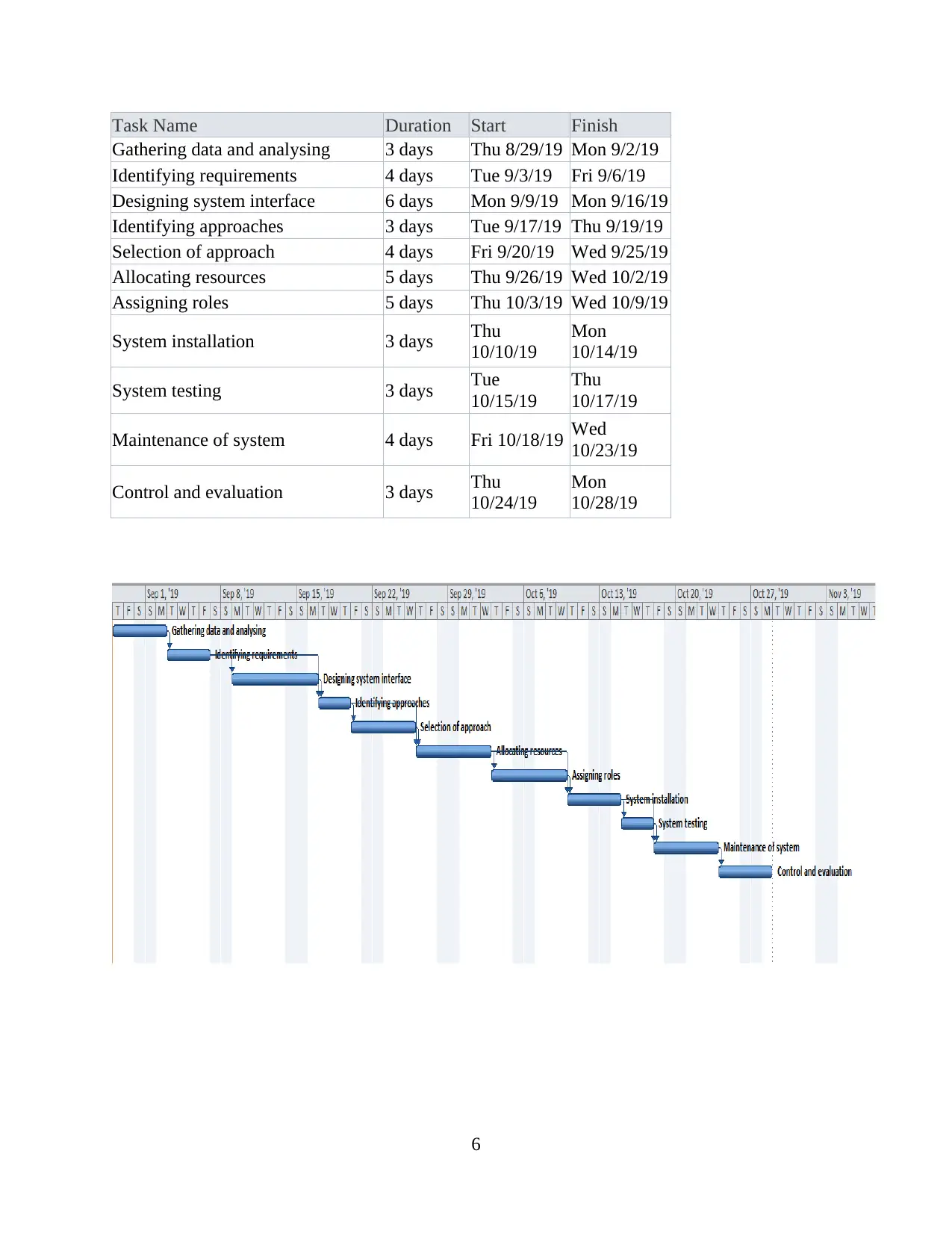
Task Name Duration Start Finish
Gathering data and analysing 3 days Thu 8/29/19 Mon 9/2/19
Identifying requirements 4 days Tue 9/3/19 Fri 9/6/19
Designing system interface 6 days Mon 9/9/19 Mon 9/16/19
Identifying approaches 3 days Tue 9/17/19 Thu 9/19/19
Selection of approach 4 days Fri 9/20/19 Wed 9/25/19
Allocating resources 5 days Thu 9/26/19 Wed 10/2/19
Assigning roles 5 days Thu 10/3/19 Wed 10/9/19
System installation 3 days Thu
10/10/19
Mon
10/14/19
System testing 3 days Tue
10/15/19
Thu
10/17/19
Maintenance of system 4 days Fri 10/18/19 Wed
10/23/19
Control and evaluation 3 days Thu
10/24/19
Mon
10/28/19
6
Gathering data and analysing 3 days Thu 8/29/19 Mon 9/2/19
Identifying requirements 4 days Tue 9/3/19 Fri 9/6/19
Designing system interface 6 days Mon 9/9/19 Mon 9/16/19
Identifying approaches 3 days Tue 9/17/19 Thu 9/19/19
Selection of approach 4 days Fri 9/20/19 Wed 9/25/19
Allocating resources 5 days Thu 9/26/19 Wed 10/2/19
Assigning roles 5 days Thu 10/3/19 Wed 10/9/19
System installation 3 days Thu
10/10/19
Mon
10/14/19
System testing 3 days Tue
10/15/19
Thu
10/17/19
Maintenance of system 4 days Fri 10/18/19 Wed
10/23/19
Control and evaluation 3 days Thu
10/24/19
Mon
10/28/19
6

WBS and gantt chart are related to each other. The activities described in WBS are base
of gantt chart. Both provides schedule of project and what resources will be used.
It can be analyzed that to develop a new system project schedule is not reasonable. This
is because in that time assigned to activity are not sufficient. Moreover, it is difficult to install
new system in less time. This can result in ineffective completion of project. Beside it, system
might not be properly installed and can lead to error or faults.
System Information Requirement Investigation Techniques
For designing a new system there are many stakeholders involved. They play vital role in
taking decision by providing useful information (Prokofyeva and Boltunova, 2017). In Repair
made easy stakeholders involved are:-
Customers – they are involved because it will support in interacting with system.
Employees- Employees are involved in taking crucial decision. They will support in designing
of system.
Suppliers – the system is used by suppliers so they provide info what feature or change can be
implemented.
There are different techniques available for investigating system requirements. They are
explained below :-
Survey – It is a technique which allows collecting information from large number of people.
Here, questions are asked to them based on project objective. This gives relevant and proper info
about how process should start, what inputs are required, etc. This technique is chosen as
suppliers, customer, etc. will provide precise info about system.
Analysing existing documents- This is also a method to gather data by reviewing current
system and process. The manager understands about business system, process, user, etc. So, it
gives insight on how system is working. This technique is taken so that Repair made easy IS is
analyzed and data is collected. Thus, developer will make changes in new system by finding out
weakness and improving it.
User observation – It is direct approach in which system is observed to collect data.
Furthermore, by taking feedback of user info is gathered (Cats and Loutos, 2016). This
technique is taken in company as it will enable in finding gap. Also, it will provide real time
data.
7
of gantt chart. Both provides schedule of project and what resources will be used.
It can be analyzed that to develop a new system project schedule is not reasonable. This
is because in that time assigned to activity are not sufficient. Moreover, it is difficult to install
new system in less time. This can result in ineffective completion of project. Beside it, system
might not be properly installed and can lead to error or faults.
System Information Requirement Investigation Techniques
For designing a new system there are many stakeholders involved. They play vital role in
taking decision by providing useful information (Prokofyeva and Boltunova, 2017). In Repair
made easy stakeholders involved are:-
Customers – they are involved because it will support in interacting with system.
Employees- Employees are involved in taking crucial decision. They will support in designing
of system.
Suppliers – the system is used by suppliers so they provide info what feature or change can be
implemented.
There are different techniques available for investigating system requirements. They are
explained below :-
Survey – It is a technique which allows collecting information from large number of people.
Here, questions are asked to them based on project objective. This gives relevant and proper info
about how process should start, what inputs are required, etc. This technique is chosen as
suppliers, customer, etc. will provide precise info about system.
Analysing existing documents- This is also a method to gather data by reviewing current
system and process. The manager understands about business system, process, user, etc. So, it
gives insight on how system is working. This technique is taken so that Repair made easy IS is
analyzed and data is collected. Thus, developer will make changes in new system by finding out
weakness and improving it.
User observation – It is direct approach in which system is observed to collect data.
Furthermore, by taking feedback of user info is gathered (Cats and Loutos, 2016). This
technique is taken in company as it will enable in finding gap. Also, it will provide real time
data.
7
⊘ This is a preview!⊘
Do you want full access?
Subscribe today to unlock all pages.

Trusted by 1+ million students worldwide
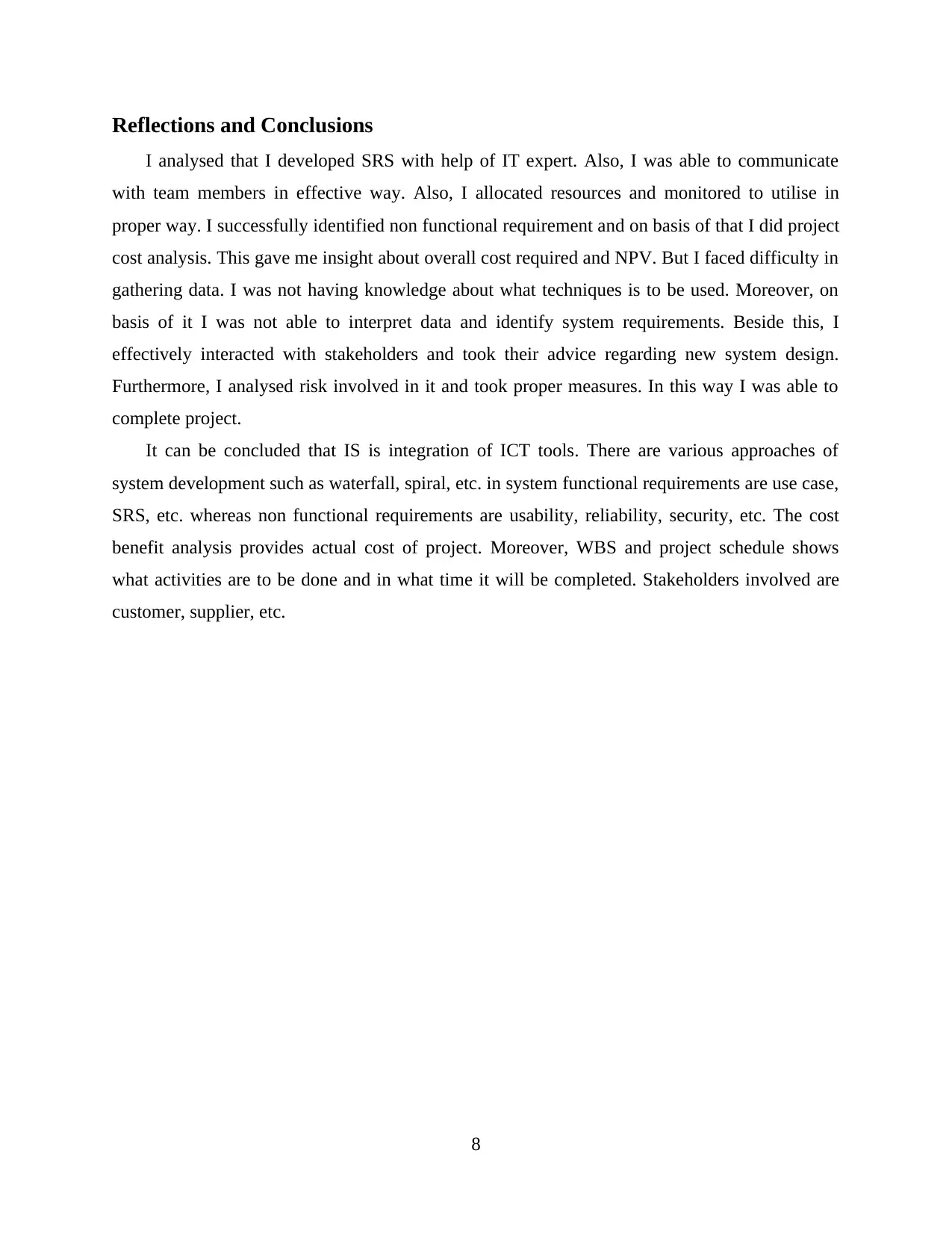
Reflections and Conclusions
I analysed that I developed SRS with help of IT expert. Also, I was able to communicate
with team members in effective way. Also, I allocated resources and monitored to utilise in
proper way. I successfully identified non functional requirement and on basis of that I did project
cost analysis. This gave me insight about overall cost required and NPV. But I faced difficulty in
gathering data. I was not having knowledge about what techniques is to be used. Moreover, on
basis of it I was not able to interpret data and identify system requirements. Beside this, I
effectively interacted with stakeholders and took their advice regarding new system design.
Furthermore, I analysed risk involved in it and took proper measures. In this way I was able to
complete project.
It can be concluded that IS is integration of ICT tools. There are various approaches of
system development such as waterfall, spiral, etc. in system functional requirements are use case,
SRS, etc. whereas non functional requirements are usability, reliability, security, etc. The cost
benefit analysis provides actual cost of project. Moreover, WBS and project schedule shows
what activities are to be done and in what time it will be completed. Stakeholders involved are
customer, supplier, etc.
8
I analysed that I developed SRS with help of IT expert. Also, I was able to communicate
with team members in effective way. Also, I allocated resources and monitored to utilise in
proper way. I successfully identified non functional requirement and on basis of that I did project
cost analysis. This gave me insight about overall cost required and NPV. But I faced difficulty in
gathering data. I was not having knowledge about what techniques is to be used. Moreover, on
basis of it I was not able to interpret data and identify system requirements. Beside this, I
effectively interacted with stakeholders and took their advice regarding new system design.
Furthermore, I analysed risk involved in it and took proper measures. In this way I was able to
complete project.
It can be concluded that IS is integration of ICT tools. There are various approaches of
system development such as waterfall, spiral, etc. in system functional requirements are use case,
SRS, etc. whereas non functional requirements are usability, reliability, security, etc. The cost
benefit analysis provides actual cost of project. Moreover, WBS and project schedule shows
what activities are to be done and in what time it will be completed. Stakeholders involved are
customer, supplier, etc.
8
Paraphrase This Document
Need a fresh take? Get an instant paraphrase of this document with our AI Paraphraser

REFERENCES
Books and Journals
Cats, O. and Loutos, G., 2016. Real-time bus arrival information system: an empirical
evaluation. Journal of Intelligent Transportation Systems, 20(2), pp.138-151.
de Gusmão, A.P.H. and et.al., 2016. Information security risk analysis model using fuzzy
decision theory. International Journal of Information Management, 36(1), pp.25-34.
Gordon, M.I. and et.al., 2015, February. Information flow analysis of android applications in
droidsafe. In NDSS (Vol. 15, No. 201, p. 110).
Gourlis, G. and Kovacic, I., 2017. Building Information Modelling for analysis of energy
efficient industrial buildings–A case study. Renewable and Sustainable Energy
Reviews, 68, pp.953-963.
Hughes, D.L. and et.al., 2016. Information systems project failure–analysis of causal links using
interpretive structural modelling. Production Planning & Control, 27(16), pp.1313-1333.
Liang, J. and et.al., 2015. An open-source 3D solar radiation model integrated with a 3D
Geographic Information System. Environmental Modelling & Software, 64, pp.94-101.
Prokofyeva, N. and Boltunova, V., 2017. Analysis and Practical Application of PHP Frameworks
in Development of Web Information Systems. Procedia Computer Science, 104, pp.51-
56.
Online
SDLC approaches, 2016. [online] Available through : <
https://tech-talk.org/2015/01/21/system-development-life-cycle-sdlc-approaches/ >
9
Books and Journals
Cats, O. and Loutos, G., 2016. Real-time bus arrival information system: an empirical
evaluation. Journal of Intelligent Transportation Systems, 20(2), pp.138-151.
de Gusmão, A.P.H. and et.al., 2016. Information security risk analysis model using fuzzy
decision theory. International Journal of Information Management, 36(1), pp.25-34.
Gordon, M.I. and et.al., 2015, February. Information flow analysis of android applications in
droidsafe. In NDSS (Vol. 15, No. 201, p. 110).
Gourlis, G. and Kovacic, I., 2017. Building Information Modelling for analysis of energy
efficient industrial buildings–A case study. Renewable and Sustainable Energy
Reviews, 68, pp.953-963.
Hughes, D.L. and et.al., 2016. Information systems project failure–analysis of causal links using
interpretive structural modelling. Production Planning & Control, 27(16), pp.1313-1333.
Liang, J. and et.al., 2015. An open-source 3D solar radiation model integrated with a 3D
Geographic Information System. Environmental Modelling & Software, 64, pp.94-101.
Prokofyeva, N. and Boltunova, V., 2017. Analysis and Practical Application of PHP Frameworks
in Development of Web Information Systems. Procedia Computer Science, 104, pp.51-
56.
Online
SDLC approaches, 2016. [online] Available through : <
https://tech-talk.org/2015/01/21/system-development-life-cycle-sdlc-approaches/ >
9
1 out of 11
Related Documents
Your All-in-One AI-Powered Toolkit for Academic Success.
+13062052269
info@desklib.com
Available 24*7 on WhatsApp / Email
![[object Object]](/_next/static/media/star-bottom.7253800d.svg)
Unlock your academic potential
© 2024 | Zucol Services PVT LTD | All rights reserved.





